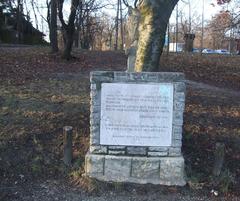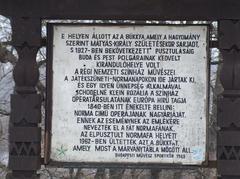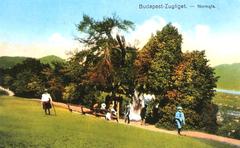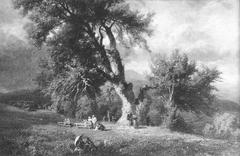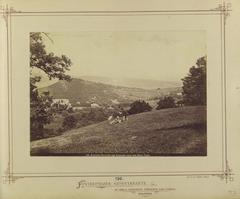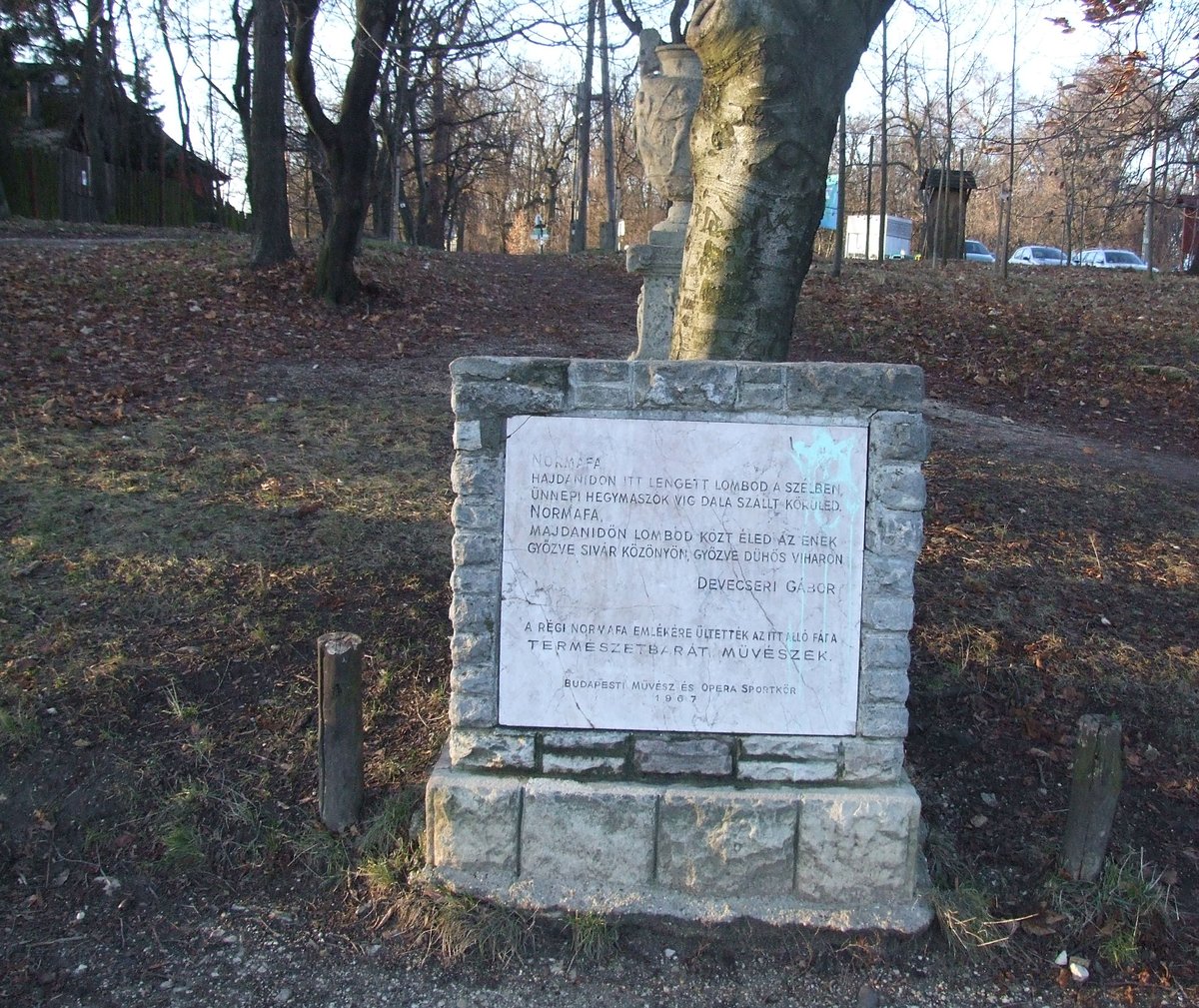
Normafa Visiting Hours, Tickets, and Historical Sites in Budapest
Date: 14/06/2025
Introduction to Normafa Budapest and Its Significance
Perched atop the scenic Buda Hills, Normafa stands as one of Budapest’s most treasured natural and cultural landmarks. With sweeping panoramic views, a storied past, and year-round recreational opportunities, Normafa is beloved by both locals and tourists. Its origins date back to a legendary beech tree—once called “Viharbükk” or “Storm Beech”—which inspired the Hungarian National Theatre troupe in the 19th century. The area’s renaming after Vincenzo Bellini’s opera “Norma” links it to Hungary’s artistic heritage, making it a symbol of both nature and culture (Normafa Park; Wikipedia).
Today, Normafa is an accessible haven offering hiking, cross-country skiing, and family outings, served by historic and modern public transport. Attractions such as the Elizabeth Lookout Tower and the Imre Makovecz Observation Tower provide architectural and scenic highlights (Hungary Unlocked; Audiala). This guide gives you everything you need to plan a memorable visit, including practical tips, accessibility details, and nearby points of interest (Normafa Park Official Site; Budapest.city).
Table of Contents
- Origins and Etymology
- The Legendary Beech Tree
- Normafa’s Role in Budapest’s Development
- Cultural and Social Significance
- Sporting Heritage
- Practical Visitor Information
- Visual and Interactive Media
- Hiking, Activities, and Seasonal Highlights
- Family-Friendly Facilities
- Dining and Refreshments
- Amenities and Accessibility
- Conservation Efforts
- Accommodation Options
- Tips for a Memorable Visit
- Unique Experiences
- Frequently Asked Questions (FAQ)
- Summary and Final Recommendations
- References
Origins and Etymology
Normafa’s story begins with the legendary beech tree that once stood atop Svábhegy. Originally named “Viharbükk” by the area’s Swabian settlers, the tree was reputed to have sprouted in the 15th century—some tales even link it to King Matthias Corvinus (Normafa Park; Wikipedia). In 1840, opera singer Rozália Klein Schodel, inspired by the tree, performed an aria from Bellini’s “Norma” beneath its branches, cementing the name “Normafa” and imbuing the place with artistic resonance (Hegyvidék).
The Legendary Beech Tree
The original beech tree became a symbol of endurance and a focal point for community gatherings. It was felled by lightning in 1927, but the memory lives on through a commemorative plaque and in local poetry (Wikipedia; Normafa Park):
“Norma tree,
Your branches have swung with the wind through the ages,
And cheery the songs were of ramblers around you,
Norma tree,
May songs come alive in the green of your verdure,
And conquer indifference, and conquer the storm.”
Normafa’s Role in Budapest’s Development
Normafa’s growth as a recreational hub parallels Budapest’s urban expansion. The Buda Hills have been inhabited since prehistoric times, valued for their strategic and scenic qualities (Budapest by Locals). By the 19th century, Normafa became a favored escape for the city’s elite, accessible by the cogwheel railway (built in 1871) and later by car (Normafa Park).
Cultural and Social Significance
Normafa’s allure extended to artists, politicians, and families who frequented its restaurants and taverns. The tradition of excursions and open-air performances made it a cultural hotspot, with guidebooks from as early as 1844 highlighting its scenic beauty (Normafa Park).
Sporting Heritage
In the early 20th century, Normafa hosted major ski jumping events and became a center for outdoor sports. Today, it remains a year-round destination for hiking, running, cycling, and winter sports (Normafa Park; Wikipedia).
Practical Visitor Information
Visiting Hours and Tickets
- Open year-round: Dawn to dusk.
- No entry fee for the park or main trails.
- Some attractions, like the Elizabeth Lookout Tower, require tickets (approx. 800 HUF for adults; discounts for children and seniors) (Normafa Park Official Site; Budapest.city).
Getting There and Accessibility
- Public Transport: M2 metro (Széll Kálmán tér) + bus 21/21A; Cogwheel Railway from Városmajor; Chairlift (Libegő) from Zugliget (Budapest by Locals).
- Parking: Available near trailheads; regulated and fee-based during peak hours (normafapark.hu).
- Accessibility: Main paths are paved and suitable for wheelchairs/strollers, though some trails are steep or uneven (wheelchairtravel.org).
Nearby Attractions
- János Hill: The city’s highest point, with the Elizabeth Lookout Tower.
- Imre Makovecz Observation Tower: Unique wooden architecture by a celebrated Hungarian architect (Audiala).
Guided Tours and Special Events
- Guided nature walks and cultural tours are offered seasonally; check the Normafa Park website for schedules.
- Special Events: Include sledding festivals, hiking days, and open-air concerts.
Photographic Spots
- Key vistas include the Normafa Lookout, Elizabeth Lookout Tower, and panoramic clearings.
- Best light: Early morning or late afternoon.
Visual and Interactive Media
The official Normafa website features interactive maps, virtual tours, and galleries showcasing the park’s beauty (Normafa Park Official Site).
Hiking, Activities, and Seasonal Highlights
- Trails: Well-marked, varying from easy walks to challenging ascents.
- Spring/Summer: Hiking, nordic walking, biking, picnics, and the Children’s Railway (Budapest by Locals).
- Autumn: Foliage and ideal photography conditions.
- Winter: Sledding, cross-country skiing, and winter walks (Daily News Hungary).
Family-Friendly Facilities
- Playgrounds: Anna-réti features modern, safe equipment.
- Children’s Railway: Unique train ride operated by children under supervision.
Dining and Refreshments
- Restaurants and Cafés: Normafa Síház and Normakert Bistro offer traditional Hungarian fare.
- Picnic Areas: Benches and tables available; visitors are encouraged to clean up after themselves (Hungary Unlocked).
Amenities and Accessibility
- Restrooms: Public toilets available (typically 200 HUF fee; carry coins) (budappest.com).
- Seating and Shelters: Benches and covered areas with panoramic views.
- Pet-Friendly: Dogs welcome on leashes; owners must clean up after pets.
- Signage: Bilingual (Hungarian/English) for easy navigation.
Conservation Efforts
Normafa is part of the Budapest Nature Conservation Area, benefiting from habitat restoration, invasive species control, and environmental education programs.
Accommodation Options
While most visitors come for the day, guesthouses and hotels are available nearby for those seeking a nature retreat (Hungary Unlocked).
Tips for a Memorable Visit
- Best times: Spring and autumn for mild weather and scenery; winter for snow sports.
- What to bring: Sturdy shoes, water, snacks, camera.
- Stay on trails: Protect the park’s ecosystem and avoid getting lost.
- Check weather: Dress appropriately and plan accordingly.
- Public Transport: Use during peak times to avoid parking issues.
Unique Experiences
- Sunrise/sunset views: Less crowded and spectacular lighting.
- Cultural events: Open-air concerts and art installations occasionally held in the park.
- Local legends: Learn about the beech tree and the area’s history through guided walks and plaques (Daily News Hungary).
Frequently Asked Questions (FAQ)
Q: What are Normafa’s visiting hours?
A: Open daily, year-round, from dawn to dusk.
Q: Is there an entrance fee?
A: No; park access is free. Some attractions, like the Elizabeth Lookout Tower, have a small entry fee.
Q: How do I get to Normafa from the city center?
A: Take the M2 metro to Széll Kálmán tér, then bus 21/21A or the Cogwheel Railway; Libegő chairlift is an alternative.
Q: Is Normafa wheelchair accessible?
A: Main paths are accessible, but some terrain is steep or uneven. Plan ahead if using mobility aids (wheelchairtravel.org).
Q: Can I bring my dog?
A: Yes, on a leash.
Q: Are there guided tours?
A: Yes, seasonally. Check the official Normafa website for details.
Summary and Final Recommendations
Normafa is a timeless treasure, blending Budapest’s natural beauty, history, and vibrant culture. With accessible trails, family amenities, and a range of activities year-round, it’s a must-visit for anyone exploring the city. Utilize public transport for convenience, check weather and event updates, and explore nearby attractions for a complete experience. Download the Audiala app for guided tours and offline maps, and follow Normafa’s social media channels for news and tips (Normafa Park Official Site; Hungary Unlocked).
Image Suggestions:
- [Plaque commemorating the legendary Normafa beech tree] (alt: “Normafa beech tree plaque”)
- [Panoramic view of Budapest from Normafa] (alt: “Panoramic view Normafa Budapest”)
- [Cogwheel Railway at Normafa] (alt: “Cogwheel Railway Normafa”)
- [Anna-réti playground] (alt: “Anna-réti playground Normafa Budapest”)
Internal Links Suggestions:
- Budapest hiking trails
- Hungarian cultural heritage sites
- Outdoor activities in Budapest
External Links:
- Normafa Park
- Wikipedia
- Budapest by Locals
- Normafa Park Official Site
- Hungary Unlocked
- Audiala
- Budapest.city
- Daily News Hungary
- Budappest.com
- Wheelchairtravel.org
